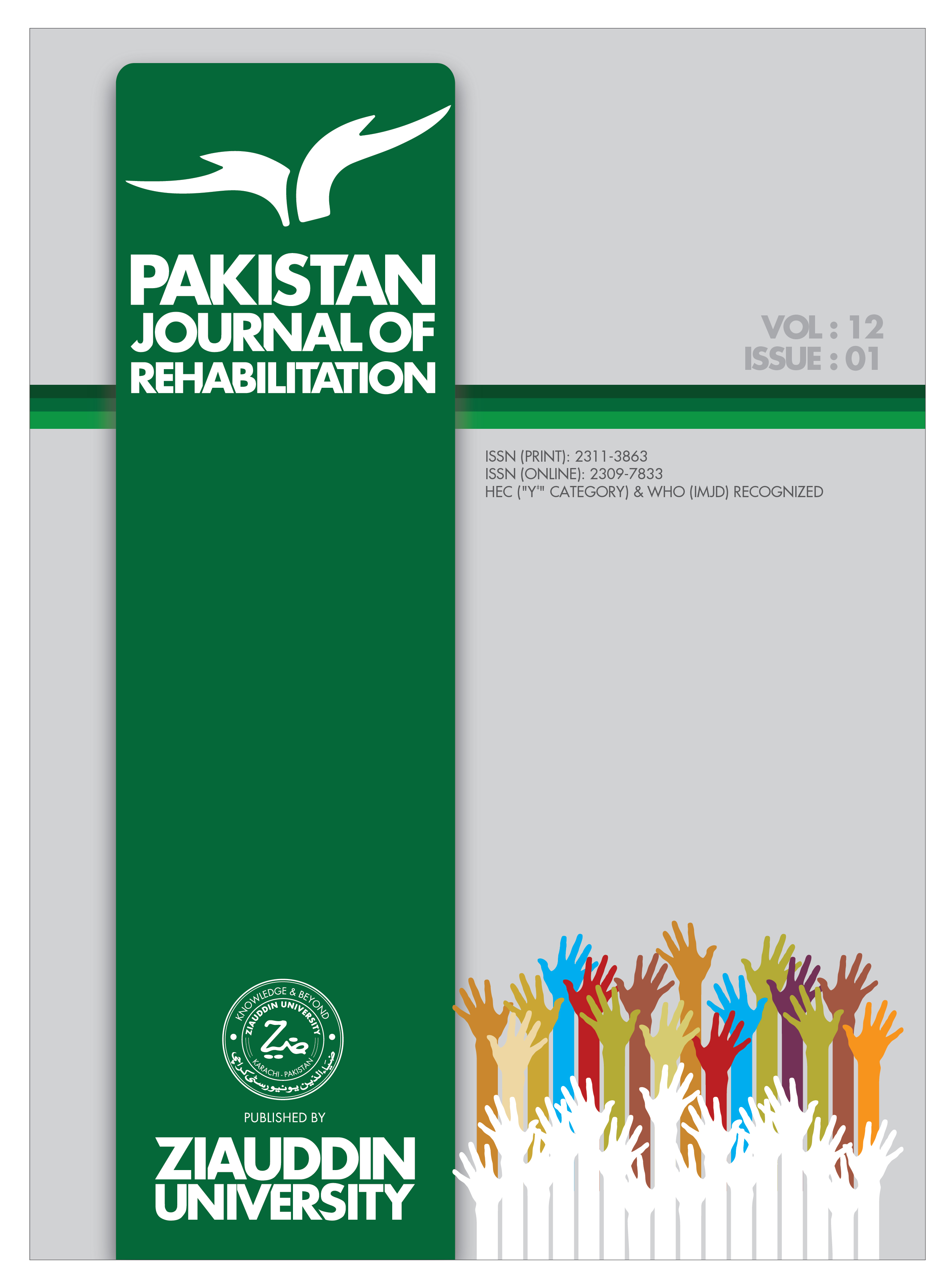QUALITY OF LIFE AMONG PHYSICALLY DISABLED FEMALES IN BACKWARD AREAS OF PAKISTAN
Keywords:
Quality of life, person with disability, physical rehabilitation, gender discrimination, prosthetics and orthotics, disability and genderAbstract
Background and Aim: Social discrimination is one of the most fatal and important source of hindrance for women causing them depressed. The aim of this research study was to find important information on QOL of physically disabled women of backward areas (Triple discriminated population of Pakistan).
Methodology: The current research was conducted at PRSP, D.I.Khan through Cross sectional survey. Sample size for current study was 300 and SF-36 was used to measure QOL. Data was analyzed by using SPSS 22.
Results: The measured mean age of the sample was 27.07 ± 11.10 years. Only 22% of the participants were married. Only 10 3.3% of the participants, completed their tertiary education. The overall SF-36 score was 47.07 ± 12.78. the domains like Physical functioning was 41.33 ± 20.38, Role physical 31.66 ± 35.61, Body pain 74.77 ± 24.06, General health 44.91 ± 14.12, Energy/fatigue 43.16 ± 16.01, Social functioning 49.37 ± 19.80, Role emotional 30.77 ± 36.53, and Mental health 45.97 ± 13.71. This study shows that education has significant impact on the QOL.
Conclusion: Physical disability has visible effects on quality of life of Female PWDs. In PWDs management, quality of life needs to be focused in Rehab program for more effective approach.
References
Faraji E, Allami M, Feizollahi N, Karimi A, Yavari A, Soroush M, et al. Health concerns of veterans with high-level lower extremity amputations. Military Medical Research. 2018;5(1):1-10.
Silva e Farias IP, Montenegro LdAS, Wanderley RL, de Pontes JCX, Pereira AC, de Almeida LdFD, et al. Physical and psychological states interfere with health-related quality of life of institutionalized elderly: a cross-sectional study. BMC geriatrics. 2020;20(1):1-10.
Mughal A, Chaudhary A. LEVEL OF MOBILITY AND ITS ASSOCIATION WITH QUALITY OF LIFE IN LOWER LIMB AMPUTEES: soi: 21-2017/re-trjvol04iss02p167. The Rehabilitation Journal. 2020;4(02):167-71.
Maini A, Heera S. Exploring disability inclusion in organizations through managerial lens. Vision. 2019;23(2):144-51.
Blattner CE. Right to work or refusal to work: Disability rights at a crossroads. Disability & Society. 2021;36(9):1375-98.
Sa'adah N, Wedadjati RS, Asmara AF. Evaluating equal employment opportunity in Indonesian industries to accommodate disabled workers. International Journal of Business and Systems Research. 2022;16(5-6):624-43.
Rathore FA, Mansoor SN. Disability rights and management in Pakistan: time to face the bitter truth. J Coll Physicians Surg Pak. 2019;29(12):1131-32.
Khan MJ, Dogar SF, Masroor U. Family relations, quality of life and post-traumatic stress among amputees and prosthetics. Pakistan Armed Forces Medical Journal (PAFMJ). 2018;68(1):125-30.
Lyså IM. Barriers to Girls Education in Rural Pakistan: NTNU; 2020.
Arrasate Hierro-Olavarría M. Procesos de llegada y experiencias educativas de mujeres de origen pakistaní en Barcelona2018.
Yousaf F. Women, patriarchy, AND TRADITIONAL METHODS: A postcolonial feminist critique of pashtun Jirga. Routledge Handbook of Feminist Peace Research: Routledge; 2021. p. 89-98.
Naseer N. Women's Rights Movement in the US: Inspirational Frame of Empowerment for Tribal Women in the Newly Merged Tribal Districts (Former FATA). Pakistan Journal of American Studies. 2022;40(1).
Zeb K, Ahmed ZS. Structural violence and terrorism in the federally administered tribal areas of Pakistan. Civil Wars. 2019;21(1):1-24.
Rehman FU. Does Military Intervention Reduce Violence? Evidence from Federally Administered Tribal Area of Pakistan (2001–2011). The Journal of Development Studies. 2018;54(9):1572-92.
Ullah H. Post-Primary Girls Education in the Newly Merged Districts of Khyber Pakhtunkhwa. Journal of Elementary Education. 2022;31(2):13-30.
Lo JK, Robinson LR. Post‐polio syndrome and the late effects of poliomyelitis: Part 2. treatment, management, and prognosis. Muscle & nerve. 2018;58(6):760-9.
Ayyaswamy B, Saeed B, Anand A, Chan L, Shetty V. Quality of life after amputation in patients with advanced complex regional pain syndrome: a systematic review. EFORT Open Reviews. 2019;4(9):533-40.
Trani J-F, Bakhshi P, Brown D, Lopez D, Gall F. Disability as deprivation of capabilities: Estimation using a large-scale survey in Morocco and Tunisia and an instrumental variable approach. Social Science & Medicine. 2018;211:48-60.
Fateh HR, Askary-Kachoosangy R, Shirzad N, Akbarzadeh-Baghban A, Fatehi F. Effect of energy conservation strategies on fatigue, function, and quality of life in adults with motor neuron disease: Randomized controlled trial. Current Journal of Neurology. 2022:83-90.
Schanke A-K, Festvåg LV, Strømsholm G, Stanghelle JK, Rike P-O, Løvstad M. Elderly Norwegian Polio Survivors: Predictors of self-perceived physical and psychological health. Edorium Journal of Disability and Rehabilitation. 2018;4.
Ganesh GS, Marwah D, Punyal S, Gupta S. Physical activity and quality of life predictors among university students with polio in India: A cross-sectional study. Journal of Clinical and Translational Research. 2020;6(3):71.
Wang MH, Brooks JM, Iwanaga K, Wu JR, Chen X, Lee B, et al. Reducing the Effect of Functional Disability on Life Satisfaction Among Persons With a Lived Experience of an Infectious Viral Disease in Taiwan: A Tri-Mediation Model. Rehabilitation Counseling Bulletin. 2022;65(3):238-48.
Verma AA, Jimenez MP, Tangermann RH, Subramanian S, Razak F. Insecurity, polio vaccination rates, and polio incidence in northwest Pakistan. Proceedings of the National Academy of Sciences. 2018;115(7):1593-8.
Liaqat M, Shaukat S, Babur MN. Exploring Past, Present and Future of Orthotics and Prosthetics in Pakistan. International Islamic Medical Journal. 2021;2(2):47-53.
Grisé E, Boisjoly G, Maguire M, El-Geneidy A. Elevating access: Comparing accessibility to jobs by public transport for individuals with and without a physical disability. Transportation Research Part A: Policy and Practice. 2019;125:280-93.
Sulaiman SK, Aldersey HM, Fayed N, Kaka B. Exploring the perception of quality of life of polio survivors in Northwest Nigeria. Applied Research in Quality of Life. 2021;16(3):1369-89.

Downloads
Published
How to Cite
Issue
Section
License
Copyright (c) 2022 Pakistan Journal of Rehabilitation

This work is licensed under a Creative Commons Attribution 4.0 International License.



